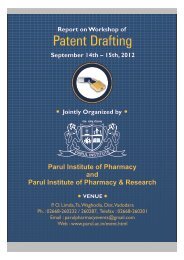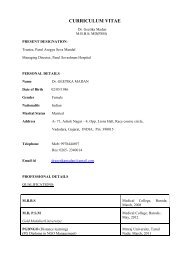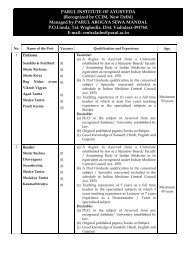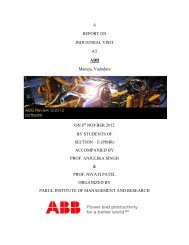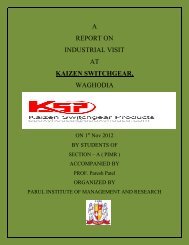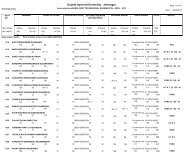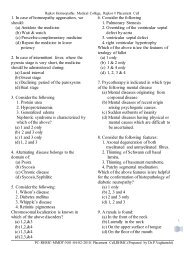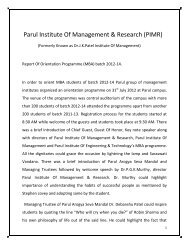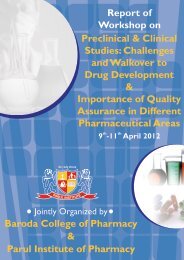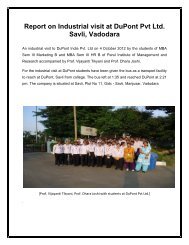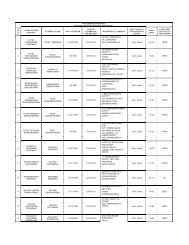2nd BHMS Syllabus - Parul Group of Institutes
2nd BHMS Syllabus - Parul Group of Institutes
2nd BHMS Syllabus - Parul Group of Institutes
You also want an ePaper? Increase the reach of your titles
YUMPU automatically turns print PDFs into web optimized ePapers that Google loves.
RAJKOT HOMOEOPATHIC MEDICAL COLLEGE<br />
Accredited Grade B by NAAC<br />
ISO 9001 : 2000 Certified<br />
Homoeopathy (Degree Course)<br />
2 nd B.H.M.S.<br />
Homoeopathy (Degree Course) Regulation,1983<br />
Notified in the Official Gazette <strong>of</strong> Government <strong>of</strong><br />
India, New Delhi, the 24th September, 2003 and<br />
implemented from the commencement <strong>of</strong> the<br />
academic session (2003-2004).<br />
Gondal Road, B/H Jainath Petrol Pump, Rajkot- 360002 (Gujarat)<br />
Ph No. 0281-2361372 Fax No.:0281-2373210<br />
E-Mail: rhmc_rajkot@yahoo.com
CONTENTS<br />
Sr.No. Page<br />
No.<br />
01. Preface<br />
02. Personal Detail<br />
03. About Institution<br />
04. Vision and Mission<br />
05. Quality Policy<br />
06. Departments [Map]<br />
07. List <strong>of</strong> Subjects with relevant Detail<br />
(1) Pathology<br />
<strong>Syllabus</strong> with Workload<br />
Exam pattern according to CCH with marking system<br />
Paper style according to Saurastra University<br />
(2) Forensic Medicine & Toxicology<br />
(a) <strong>Syllabus</strong> with Workload<br />
(b) Exam pattern according to CCH with marking system<br />
(c) Paper style according to Saurastra University<br />
(3) Materia Medica<br />
(a) <strong>Syllabus</strong> with Workload<br />
(b) Exam pattern according to CCH with marking system<br />
(c) Paper style according to Saurastra University<br />
(4) Organon <strong>of</strong> Medicine and Psychology<br />
(a) <strong>Syllabus</strong> with Workload<br />
(b) Exam pattern according to CCH with marking system<br />
(c) Paper style according to Saurastra University<br />
(5) Practice <strong>of</strong> Medicine<br />
(a) <strong>Syllabus</strong> with Workload<br />
(6) Surgery<br />
(a) <strong>Syllabus</strong> with Workload<br />
(7) Gynecology<br />
(a) <strong>Syllabus</strong> with Workload<br />
08. General guidelines for admission to<br />
Examination and scheme <strong>of</strong> examination<br />
09. Awards in exam
Preface<br />
Life is a constant learning process, after learning & imbibing the knowledge one<br />
can focus him/her to enhance it for growth and development. In this respect, it was found that<br />
students <strong>of</strong> <strong>BHMS</strong> (UG Course) are getting confused to understand the <strong>Syllabus</strong>, Examination<br />
pattern, Gradation as well as Eligibility criteria <strong>of</strong> getting admission in subsequent year as the<br />
existing syllabus is compilation <strong>of</strong> all the four years <strong>of</strong> <strong>BHMS</strong>. The rules and regulation has been<br />
kept in different places. Therefore, the Apex body <strong>of</strong> institution decided to compile the syllabus in<br />
systematize manner. I feel proud to get this opportunity to compile the syllabus and rules and<br />
regulation concern to each year separately for easy reference <strong>of</strong> the students. This is a sincere effort<br />
to simplify the syllabus.<br />
I am obliged to our beloved Managing Trustee Dr.J.K.Patel who is our inspiration<br />
for innovation. I am thankful to Dr.B.P.Panda, Principal and the Chairman <strong>of</strong> Apex Body to provide<br />
this opportunity to me. I extend my thanks to Dr. Amar Sheth, Dr.Prabhat Vaghamshi, Dr.Dharti<br />
Padariya (Faculty Member) and Mr.Kaushik Rathod (Office Staff) for their wholehearted support to<br />
complete this task.<br />
I hope this year wise academic syllabus will be helpful to the students.<br />
Dr. Mitesh Jani<br />
Pr<strong>of</strong>essor<br />
Rajkot Homeopathic Medical College
Personal Details<br />
Name __________________________________________________<br />
Roll No. _____________________ Class ___________________<br />
Admission Year_________________________________________<br />
Address ________________________________________________<br />
_______________________________________________________<br />
Pin code ______________________ Ph. No. _________________<br />
E-Mail __________________________________________________<br />
Driving License No. _______________________________________<br />
Blood <strong>Group</strong> _____________________________________________<br />
IN CASE OF ILLNESS OR ACCIDENT, INFORM<br />
Name ___________________________________________________<br />
Address _________________________________________________<br />
________________________________________________________<br />
___________________________ Pin code _____________________<br />
Phone No. __________________ Mobile No. __________________
About Institution<br />
Rajkot Homoeopathic Medical College is a Leading & reputed<br />
Homoeopathic College <strong>of</strong> Saurashtra region established since 1997. College is<br />
recognized by Central Council <strong>of</strong> Homoeopathy, New Delhi and permanently affiliated to<br />
Saurashtra University, Rajkot. Also it is recognized by Government <strong>of</strong> Gujarat and<br />
Government <strong>of</strong> India. Institution is accredited B Grade by NAAC (National Assessment<br />
and Accreditation Council). It is the second institution in Gujarat and fourth in India to<br />
own such credit. Also owns certificate <strong>of</strong> ISO 9001: 2000.<br />
Since establishment the institution has produced quality doctors, who are<br />
working successfully in the field as a private practitioner, as a Medical Officers in<br />
reputed and local hospitals <strong>of</strong> the state, in the 108 emergency medical service <strong>of</strong> Gujarat<br />
Government, Government P.H.C. / C.H.C., as an Honorary Physician in the medical<br />
charitable trust and industries <strong>of</strong> their area, as a faculty in various Homoeopathic colleges<br />
<strong>of</strong> Gujarat and other State <strong>of</strong> India. We are proud that our products have gained<br />
reputation, name and fame in the field due to the quality <strong>of</strong> work they have done.<br />
E-Mail: rhmc_rajkot@yahoo.com<br />
Web Site: http://www.parul.ac.in
Vision_____________________________________<br />
To establish a ‘Gurukulam Par Excellence’ by making „quality‟ the defining element <strong>of</strong><br />
education.<br />
Mission____________________________________<br />
To transform the student in a way that will bring a new value system in their<br />
thought process, create and innovate newer things for the benefit <strong>of</strong> society as a<br />
whole.<br />
The changes sought are:<br />
From Qualification to Education<br />
What “I can get” to what “I can give”<br />
“External Evaluation” to “Self Evaluation”<br />
“I can‟t” to “I can”<br />
“I” to “We”
GENERAL PATHOLOGY AND MICROBIOLOGY<br />
(INCLUDING PARASITOLOGY. BACTERIOLOGY AND VIROLGY)<br />
<strong>Syllabus</strong><br />
Study <strong>of</strong> Pathology must be in relation with Concept <strong>of</strong> Miasm as evolved by Dr. Hahnemann and further<br />
developed by Kent, Boger, Robert and Allen. Concept <strong>of</strong> Miasm in view <strong>of</strong> Pathology. Reference to Koch's Postulate.<br />
importance <strong>of</strong> susceptibility and immunity thereby homoeopathic concept <strong>of</strong> Disease and Cure.<br />
Characteristic expression <strong>of</strong> each miasm.<br />
Classification <strong>of</strong> symptoms/disease according to Pathology.<br />
Correlation <strong>of</strong> Miasm and Pathoiogy for e.g. Psora - inflammation<br />
Natural evolution in Pathology.<br />
Resolution - Inflammatory exudative.<br />
Degeneration. Suppurative.<br />
Interpretation <strong>of</strong> Pathological report <strong>of</strong> all diseases and correlate the utility <strong>of</strong> it in.<br />
Homoeopathic system <strong>of</strong> Medicine.<br />
Similarly all the topics in Genera! Pathology and Systemic Pathology must be co-related, at each juncture, so that<br />
the importance <strong>of</strong> Pathology is understood by a Under-Graduate student in Homoeopathy.<br />
Topics <strong>of</strong> General Pathology in Relation with Miasms.<br />
Inflamation. Repair Healing Injury<br />
Immunity.<br />
Degeneration.<br />
Neoplasm.<br />
Thrombosis.<br />
Embolism.<br />
Oedema.<br />
Disturbance <strong>of</strong> Pigment Metabolism.<br />
Calcium Metabolism.<br />
Uric Acid Metabolism.<br />
AmminoAdd Metabolism.<br />
Carbohydrate Metabolism.<br />
Fat Metabolism.<br />
Healing.<br />
Hypertrophy.<br />
Hyperplaisa.<br />
Anaplasia.<br />
Metaplasia.<br />
Ischaemia.<br />
Haemorrhage.<br />
Shock.<br />
Atrophy.<br />
Relaxation.<br />
Hyperemia.<br />
Infection.<br />
Pyrexia.<br />
Necrosis.<br />
Gangrene.<br />
Infarction<br />
SYSTEMIC PATHOLOGY.<br />
. In each system the important and common disease should be done. By keeping in view i <strong>of</strong> presentation, progress<br />
and outcome <strong>of</strong> the disease. For e.g.<br />
in Alimentary System<br />
Tongue<br />
Oral Cavity<br />
Oesophagus<br />
Stomach<br />
Duodenum<br />
Intenstine Small and Large<br />
Appendix<br />
Ulcer, Tumour<br />
Thrush, Tumour<br />
Inflammatory Disease, Tumour<br />
Inflammatory Disease<br />
Auto Immune Disease<br />
Tumour<br />
Inflammatory Disease, Acid Pepsin Digestion.<br />
Ulcers, Infection,<br />
Tumour, Malabsorption.
Liver<br />
Gall Bladder<br />
Pancreas<br />
Cardio Vascular Disease<br />
Central Nervous Disease<br />
Respiratory Disorders<br />
Kidneys<br />
Genitals Male and Female<br />
Skeletal and Muscular Disease<br />
Skin<br />
Clinical Pathology<br />
Clinical and Chemical Pathology:<br />
Practical<br />
Inflammatory Disease<br />
Inflammatory Disease<br />
Tumours<br />
Cirrhosis<br />
Jaundice<br />
Inflammatory Disease<br />
Tumour<br />
Inflammatory Disease<br />
Tumour<br />
Common Disorder<br />
Common Disorders<br />
Common Disease<br />
Common Disorders<br />
Tumours<br />
Urodynamics<br />
Common Disorder<br />
Tumours<br />
Common Disorders<br />
Common Disorders, Melanoma,<br />
Complete Haematology.<br />
Estimation <strong>of</strong> hemoglobin (by acidometry) - Count <strong>of</strong> R.B.Cs. and W.B.Cs. Staining <strong>of</strong> thin and thick films,<br />
differential counts and parasites.<br />
Erythrocyte sedimentation rate, urine, physical, chemical microscopically, quantity <strong>of</strong> albumin and sugar,<br />
faeces-physical chemical (occult blood) add microcosmical for ova and protozoa.<br />
Methods <strong>of</strong> sterilization, preparation <strong>of</strong> a media, use <strong>of</strong> microscope Gram and acid fast stains. Motility<br />
preparation. Gram positive and negative. positive and negative cocci and bacilli. Special stains<br />
for corynebacterium -gram and acid fast stains <strong>of</strong> pus and sputum.<br />
Haconkey's plate-sugar reactions-gram and motility <strong>of</strong> gram negative intestinal bacteria, Widal and<br />
demonstration <strong>of</strong> pasteur and <strong>of</strong> spirochaetes by dark field illumination. Fountain's strain-Lovaditt's stain.<br />
Demonstration <strong>of</strong> Methods <strong>of</strong> nacrobiosis.<br />
Histopathology<br />
Common teaching slide from each systems, Demonstration <strong>of</strong> gross Pathological specimen. Practical demonstration <strong>of</strong><br />
Histopathological techniques i.e. Fixation. Embedding.<br />
Sectioning staining by common dyes and strain.<br />
Frozen section. Its importance.<br />
Electron Microscopy.<br />
Phase contrast microscopy.<br />
1. Bacteriology:<br />
Morphology, biology, sterilization, chemotherapy, principles <strong>of</strong> artificial media, infection, defence reaction,<br />
immunity, hypersensitiveness, skin tests, systematic study <strong>of</strong> bacterial habits, importance-morphological,<br />
cultural, bio-chemical, serological and toxic behaviour <strong>of</strong> the common pathogenic and nonpathogenic species.<br />
Pathologic changes produced by diseases-bacteria and their laboratory diagnosis. Staphylococci, streptococci,<br />
diplococcic, Neisseria, Mycobacterium tuberculosis (types) Mycobacterium leprae, names and differentiation <strong>of</strong><br />
spirochetes from pathogenic mycobacterium, corynebacterium diphtheria. Aerobic spore bearing bacteria-<br />
Bacillus anthracis, anaerobes, general and special features <strong>of</strong> the pathogens. Names <strong>of</strong> some importance nonpathogens.<br />
Gram negative intestinal bacteria classification, identification <strong>of</strong> the pathogen Salmonella, Vibrio<br />
bacterium, Pasterurella, general idea about haemophiles, Pseudomonas, Brucella, Ricketsia, Proteus,<br />
spirochaetes-general idea details <strong>of</strong> Treponema pallidum and leptospiraictero haemorrhagica.<br />
Viruses-general characters, classification <strong>of</strong> disease e.g. varecella, Rabies, Bacteriophage Koch’s postulates.<br />
2. Parasitology:<br />
Protozoa-classification names <strong>of</strong> important rhizopoda, Ent. histolytica, morphology, pathogenesis and<br />
pathogenecity, diagnosis, differences from Ent. coli sporozea species <strong>of</strong> plasmodia life history and pathogenesis<br />
differentiation <strong>of</strong> species.
Mastigophora-generai broad morphological features classification, oathogenesis. vectors, pathology <strong>of</strong> Kala-<br />
Azar, important Teaiures source Disease aue to baiantiaium coii.<br />
Helimnths-definilion <strong>of</strong> certain terms, simple classification, differences between nematodes cestodoes and<br />
treamatodes Broad differentiating morphological features and broad life history and pathogenesis <strong>of</strong> important<br />
species. Cestodes and Nematodes-infecting liver, lungs, intestines and blood-general differences between<br />
schislosomes and other trematodes<br />
2. VIROLOGY:<br />
Diagnosis' <strong>of</strong> Infectious Diseases host Parasite Relationship. Disinfectants. Mode <strong>of</strong> action. Practical aspects<br />
<strong>of</strong> Immunology i.e. Application in diagnosis, Passive Immunization, Immunopathies in brief including AIDS<br />
Bacteria Genetics (briefly) .<br />
KIDNEY BLADDER URETER URETHRA<br />
Glemerulo Nephritis .<br />
Pyelonephritis .<br />
Tuberecuiar Pyelonephritis .<br />
Nephrotic Syndrom.<br />
Metabolic Diseases and Kidney.<br />
Systemic diseases and Kidney. .<br />
Acute and Chronic Renal Failure<br />
Kidney Tumours<br />
Calculi.<br />
Cystitis.<br />
Ureteric Stncture<br />
Urethritis., Specific and Non Specific.<br />
Renal Function Test in Relation to Homoeopathy.<br />
CARDIO VASCULAR DISEASES<br />
Ischaemic Heart Disease.<br />
Rheumatic Heart Disease.<br />
Valvular Heart Disease.<br />
Hypertension.<br />
Cardiomyopathy.<br />
Infective Endocarditis.<br />
Congestive Cardiac Failure.<br />
Diseases <strong>of</strong> Pericardium.<br />
Cardiogenis Shock.<br />
MALE AND FEMALE GENITAL DESEASE<br />
Testicular Tumers<br />
Acute and Chronic Prostatitis<br />
Prostatic Tummers.<br />
Sterity<br />
OA PANIS<br />
ovanan tumer<br />
Fibroids<br />
CA CERVIX<br />
Infertility<br />
Endometesis and Endometrium.<br />
Breast Inflamation and Tumers.<br />
RESPERATORY DISEASES<br />
Pulmonary function test<br />
Bronchial Asthma<br />
Bronchitis<br />
Bronochiactesis<br />
Emphysema<br />
Empyema<br />
Cor. Pulmonari<br />
Pneumonia<br />
Bronchogenic Carcinoma<br />
Interstitial Lung Diseases
GASTRO INTESTINAL DISEASES<br />
Tongue, Stomatitis, Ulcers, Tumours<br />
Oesophagus, Reflex Oesophagitis<br />
Tumour <strong>of</strong> Oesophagus<br />
Stomach, Gastritis, CA Stomach, Gastric Ulcers<br />
Liver Cirrhosis, Hepatitis, CA Liver<br />
Liver abscess.<br />
Liver Function Test<br />
Gall Stones<br />
Pancreas Acute and Chronic Pancreatitis, CA pancreas<br />
Intestines Ulcers, Duodenal colics, CA Colon and Rectum<br />
Tumours<br />
Mal absorption Syndrome<br />
Infections<br />
Appendix, Acute Appendicitis.<br />
SKIN DISEASE<br />
Infection And Tumers<br />
BONES DISEASE<br />
Sarcoma , Osteoma, Pagets Diseases<br />
Osteomyelities , Tuberculer , Osteomyelitis<br />
Rheumatoid Arthritis Osteo Arthritis<br />
GENERAL NERVOUS SYSTEM<br />
Meningitis Pyogenic/ Tubercular<br />
CEREBRO SPINAL FLUID<br />
Picture <strong>of</strong> various Diseases.<br />
ENDOCRINAL SYSTEM<br />
Workload<br />
Subject Theoretical<br />
Lecture<br />
Pathology and Microbiology including<br />
Parasitology Bacteriology and Virology.<br />
1ST - PAPER<br />
GENERAL SYSTEMATIC PATHOLOGY AND MIASMS<br />
Practical/clinical/tutorial/<br />
Seminar<br />
200 70<br />
Exam pattern according to CCH<br />
2NDPAPER –<br />
BACTERIOLOGY, PARASITOLOGY AND CLINICAL PATHOLOGY<br />
(Each Divided into Two Sections)<br />
Pathology Practical<br />
Experimental/Microbiological Spots Reading and Interpretation <strong>of</strong> Pathological Reports<br />
Examinations in Pathology and Microbiology shall consist <strong>of</strong> one theory paper and one practical<br />
including oral. Identification <strong>of</strong> microscopic slides and specimens shall be apart <strong>of</strong> practical examination.<br />
Subject Written<br />
Full<br />
Marks<br />
Marking system<br />
Pass<br />
Marks<br />
Practical(including<br />
oral)<br />
Full Marks<br />
Pass<br />
Marks<br />
Full<br />
Marks<br />
Total<br />
Pass<br />
Marks
Pathology & Microbiology 100 50 100 50 200 100<br />
Notes:<br />
Paper style according to Saurashtra University<br />
1. Each paper consists <strong>of</strong> 100 Marks which is divided in to two sections.<br />
2. Each section will carry 50 Marks.<br />
3. In each section there shall be 2 (two) long question each <strong>of</strong> 15 Marks.<br />
4. One long question may be divided in to two Bit questions <strong>of</strong> Equal Marks.<br />
5. There shall be one Short Note Question which will carry 20 Marks <strong>of</strong> equally distributed Marks in each<br />
short Question.<br />
FORENSIC MEDICINE AND TOXICOLOGY<br />
<strong>Syllabus</strong><br />
The subject is <strong>of</strong> practical importance to the students <strong>of</strong> homoeopathic medicine as homoeopathic physicians are<br />
to be s-oioyed by Government in areas where they may have to handle medico-legal-cases, perform autopsies,<br />
apart from giving evidence in such cases. The training in forensic medicine at present conducted is inadequate to<br />
meet these needs<br />
The course consist <strong>of</strong> a series <strong>of</strong> lectures and demonstration including:-<br />
1.<br />
2.<br />
3.<br />
4.<br />
Legal procedure<br />
Definition <strong>of</strong> medical Jurisprudence, courts, and their jurisdiction<br />
Medial ethics.<br />
Law relating to medical registration and medical relation between practitioner and the State. The<br />
Council <strong>of</strong> Homoeopathy Act, 1973 and the code <strong>of</strong> Ethics under it, the practitioners and the patients,<br />
Malpractices covering pr<strong>of</strong>essional secrecy, the practitioners and the patients, Malpractices covering<br />
pr<strong>of</strong>essional secrecy, the practitioner and the various legislations (Acts) Provincial and Union such as<br />
Workman's compensation Act, Public Health Act, Injuries Act, Child Marriage Registration Act, Borstal<br />
Schools Act, Medical Termination <strong>of</strong> Pregnancy Ac, Lunacy Act, Indian Evidence Act, etc.<br />
Forensic Medicine:<br />
Examination and identification <strong>of</strong> persons living and dead: Parts, bones, stains, etc. health: Medicolegal;<br />
purification, mummification; saponification, forms <strong>of</strong> death, causes, agencies, onset etc.<br />
Assaults, wounds, Injuries and death by violence. Asphyxial death, blood examination, blood stains,<br />
seminal stains; burns, scalds, lighting stroke etc. starvation, pregnancy, delivery, abortion, Infanticide,<br />
sexual rimes, Insenity in relation to the State life and accident insurance.<br />
Toxicology<br />
A separate course <strong>of</strong> lectures dealing poisoning in general, the symptoms and treatments <strong>of</strong> various<br />
poisons, post-mortem appearance and test should be given, study <strong>of</strong> the following poisons:-<br />
Mineral Acid, corressive sublimate arsenic and its compound alcohol, opium and its alkaloids,<br />
carbolic acid monoxide, carbon dioxide. Kerosene oil, cannabis indica, cocaine, belladonna, strychnin<br />
and nuxvomica, aconite, oleander, snake poisoning, prusic acid, lead poisoning.<br />
Medico legal post-mortem:<br />
Recording post mortem appearance, forwarding materials to chemical examiner; Interpretation <strong>of</strong><br />
laboratory and chemical examiner's findings. Students who are attending a course <strong>of</strong> lecture in<br />
forensic medicine should avail a themselves <strong>of</strong> all possible opportunities <strong>of</strong> attending medico-legal<br />
post-mortems conducted by the pr<strong>of</strong>essors <strong>of</strong> forensic medicine. It is expected that each student<br />
should attend at least 10 post-mortems.
5.<br />
Demonstration:<br />
1. Weapons<br />
2. Organic & Inorganic poisons.<br />
3. Poisonous plants.<br />
4. Charts, diagram, models, x-ray films etc. <strong>of</strong> medico-legal interest.<br />
Workload<br />
Subject Theoretical<br />
Lecture<br />
Practical/clinical/tutorial/<br />
Seminar<br />
Forensic Medicine & Toxicology 50 20<br />
Exam pattern according to CCH<br />
Examination in Forensic Medicine and Toxicology shall consist <strong>of</strong> one theory paper and one oral<br />
examination including identification and spotting <strong>of</strong> specimens.<br />
Notes:<br />
Marking system<br />
Subject Written<br />
Full<br />
Marks<br />
Pass<br />
Marks<br />
Practical(including<br />
oral)<br />
Full Marks<br />
Pass<br />
Marks<br />
Full<br />
Marks<br />
Total<br />
Pass<br />
Marks<br />
Forensic Medicine & Toxicology 100 50 100 50 200 100<br />
Paper style according to Saurashtra University<br />
1. Each paper consists <strong>of</strong> 100 Marks which is divided in to two sections.<br />
2. Each section will carry 50 Marks.<br />
3. In each section there shall be 2 (two) long question each <strong>of</strong> 15 Marks.<br />
4. One long question may be divided in to two Bit questions <strong>of</strong> Equal Marks.<br />
5. There shall be one Short Note Question which will carry 20 Marks <strong>of</strong> equally distributed Marks in each<br />
short Question.<br />
APPENDIX I<br />
Homeopathic Materia Medica<br />
<strong>Syllabus</strong><br />
List <strong>of</strong> Drugs included in the <strong>Syllabus</strong> <strong>of</strong> Materia Medica for the 1st B.H.M.S. Examination<br />
1. Acontite nap 2. Aethusa cyan<br />
3. Alliuum cepa 4. Aloe socotrina<br />
5. Antimonium crud 6. Antimonium tart<br />
7. Apis malefic/font> 8. Argentum nit<br />
9. Arnica Montana 10. Bryonia alb<br />
11. Chamomilla 12. Cina<br />
13. Colchium autumn 14. Colosynththis
APPENDIX II<br />
15. Dulcamera 16. Euphrasia<br />
17. Ipecac 18. Ledum pal<br />
19. Nux Vomica 20. Rhus Tox<br />
21. Calcaria flour 22. Calcarea phos<br />
23. Calcarea sulph 24. Ferrum phos<br />
25. Silicea<br />
<strong>Syllabus</strong> <strong>of</strong> Materia Medica for the II., B.H.M.S. Examination<br />
In addition to the list <strong>of</strong> drugs for the first B.H.M.S. Examination (Appendix I), the following additional drugs are<br />
included in the <strong>Syllabus</strong> <strong>of</strong> Materia Medica for the II B.H.M.S. Examination.<br />
1. Acetic Acid 2. Aceteca Racemosa<br />
3. Agaricus muscarious 4. Agnus Castus<br />
5. Alumina 6. Ambra grisea<br />
7. Ammonium Carb 8. Ammonium mur<br />
9. Anacardium ori 10. Apocynam can<br />
11. Arsnic album 12. Arsnic iod<br />
13. Aurum met 14. Arum Triph<br />
15. Baptesia tinctor 16. Berberris vulg<br />
17. Bismuth 18. Borex<br />
19. Bromium 20. Bovista<br />
21. Cactus g 22. Calcarea ars<br />
23. Calendula 24. Camphora<br />
25. Cantherrs 26. Chelidonium maj<br />
27. Conium mac 28. Digitalis per<br />
29. Drosera 30. Ferrum met<br />
31. Gelsemium 32. Helliborus<br />
33. Hepur sulph 34. Ignatia<br />
35. Kali Bron 36. Kreosatum<br />
37. Natrum Carbo 38. Nux moschata<br />
39. Opium 40. Petrolium<br />
41. Phosphorus 42. Phytolocca<br />
43. Plantina met 44. Sepia<br />
45. Spongia tost 46. Veratrum alb<br />
47. Kali mur 48. Kali phos<br />
49. Magnesia Ph 50. Natrum sulph<br />
Workload<br />
Subject Theoretical<br />
Lecture<br />
Practical/clinical/tutorial/<br />
Seminar<br />
Homeopathic Materia Medica 75 75<br />
Exam pattern according to CCH<br />
Examination in Materia Medica shall consist <strong>of</strong> one theory paper and one practical including oral<br />
examination.<br />
Marking system
Notes:<br />
Subject Written<br />
Full<br />
Marks<br />
Pass<br />
Marks<br />
Practical(including<br />
oral)<br />
Full Marks<br />
Pass<br />
Marks<br />
Full<br />
Marks<br />
Total<br />
Pass<br />
Marks<br />
Homoeopathic Materia Medica 100 50 100 50 200 100<br />
Paper style according to Saurashtra University<br />
1. Each paper consists <strong>of</strong> 100 Marks which is divided in to two sections.<br />
2. Each section will carry 50 Marks.<br />
3. In each section there shall be 2 (two) long question each <strong>of</strong> 15 Marks.<br />
4. One long question may be divided in to two Bit questions <strong>of</strong> Equal Marks.<br />
5. There shall be one Short Note Question which will carry 20 Marks <strong>of</strong> equally distributed Marks in each<br />
short Question.<br />
ORGANON OF MEDICINE AND PRINCIPLES OF<br />
HOMOEOPATHIC PHILOSOPHY & PSYCHOLOGY<br />
<strong>Syllabus</strong><br />
Section 1<br />
Hahnemann's Organon <strong>of</strong> Medicine Aphorism: 1 to 145<br />
The purpose <strong>of</strong> Homeopathic case taking is not merely collection <strong>of</strong> symptoms but comprehending the PERSON IN WIDER<br />
DIMENSION with the correct appreciation <strong>of</strong> the factors responsible for the genesis and maintenance <strong>of</strong> illness i.e.<br />
Fundamental Cause, PREDISPOSING CAUSE, MAINTAINING CAUSE & ONE SIDED DISEASES.<br />
There should be compulsory case taking term for each student wherein he learns to build up PORTRAIT <strong>of</strong> the disease by<br />
undertaking :-<br />
(i) Evolutionary study <strong>of</strong> the patient comprising <strong>of</strong> well defined characteristics.<br />
(ii) Studying individual in His life-span and in relation to his family environment and work.<br />
(iii) Processing <strong>of</strong> the interview and the entire case so as to grasp the principles <strong>of</strong> MANAGEMENT <strong>of</strong> these patients.<br />
He should be taught to classify various symptoms which he has elicited in his case taking. He puts down his evaluation <strong>of</strong><br />
those characteristics. His capacity for analysis and synthesis should evolve. In appendix, Analytical paper for symptom<br />
classification and evaluation is attached. If practiced properly, has potential to improve analytical faculty <strong>of</strong> the student.<br />
Physician, Teaching Staff,R.M.O. and house staff shall spend enough time with the students and interns and scrutiny <strong>of</strong><br />
their written cases, discussing mode <strong>of</strong> interview and processing <strong>of</strong> the case.<br />
There should be standardization in imparting training in ANALYSIS AND EVALUATION. Each institute shall keep the standard<br />
guide-lines <strong>of</strong> Case-taking.<br />
Section 2<br />
GUIDELINES ANALYSIS - EVALUATION OF OBJECTIVES OF ANALYSIS EVALUATION OF SYMPTOMS.<br />
(1) To individualize the case so as to prepare an effective totality which allows us to arrive at the SIMILIMUM,<br />
prognosis the case, and advise management and impose necessary restrictions on mode <strong>of</strong> life and diet.<br />
(2) To infer about state susceptibility by appreciating the quality <strong>of</strong> characteristics state <strong>of</strong> susceptibility and<br />
diagnosis about miasmatic state would allow physician to formulate comprehensive plan <strong>of</strong> treatment.<br />
(3) Order <strong>of</strong> evaluation <strong>of</strong> the characteristics, <strong>of</strong> the case would become stepping stone for the reportorial totality.<br />
Section 3<br />
(iii) CLASSIFICATION OF SYMPTOMS. Their scopes and limitations in arriving as a totality.<br />
Symptom should not be considered superficially at its face value. It should be analyzed and evaluated by taking into<br />
account following factors.<br />
(i) Thorough grasp over the underlying dynamics: (Psychological, Physiological, Pathological aspects).<br />
(ii) This would demand thorough comprehension over the evolution <strong>of</strong> DISEASE, taking into account FUNDAMENTAL,<br />
EXCITING & MAINTAINING CAUSES.<br />
(iii) Knowledge <strong>of</strong> socio-cultural background is quite imperative for correct analysis and evaluation. Details regarding<br />
SYMPTOMATOLOGY can be comprehended by referring to the classical books in philosophy.
The Department <strong>of</strong> Organon & Philosophy while training in Case Taking shall co-ordinate with various other departments<br />
where student is sent for the pre-clinical and clinical training. This would ensure not only streamlining <strong>of</strong> the clinical<br />
Centres but also cultivate Homoeopathic perspective when student is attending other special clinics.<br />
EVALUATION - EXAMINATION<br />
(1) Student's performance shall be evaluated periodically. There shall be periodical card tests and internal (theory<br />
and practical) examinations in each academic year. The concerned teaching staff shall file his general report on the<br />
conduct <strong>of</strong> internal examinations and also on student's performance, which shall be discussed in departmental and<br />
interdepartmental meetings.<br />
(2) Each student appearing for II and III <strong>BHMS</strong> shall maintain one journal comprising <strong>of</strong> 20 cases (10 short and 10<br />
long cases) with complete processing <strong>of</strong> the case material for each examination, which shall be evaluated by the<br />
head <strong>of</strong> the department.<br />
(3) There shall be provisions for the internal assessment <strong>of</strong> all these examinations and journal work in the Final II and<br />
III <strong>BHMS</strong> examinations respectively.<br />
Workload<br />
Subject Theoretical<br />
Lecture<br />
Organon <strong>of</strong> Medicine and<br />
Principles <strong>of</strong> Homoeopathic<br />
125<br />
Exam pattern according to CCH<br />
Practical/clinical/tutorial/ Seminar<br />
Examination in Organon <strong>of</strong> Medicine, Principles <strong>of</strong> Homoeopathic Philosophy and Psychology shall consist<br />
<strong>of</strong> one theory paper and one oral examination.<br />
Marking system:-<br />
Practical(including<br />
Subject Written<br />
Total<br />
oral)<br />
Notes:<br />
Full<br />
Marks<br />
Pass<br />
Marks<br />
Full Marks<br />
Pass<br />
Marks<br />
Full<br />
Marks<br />
Pass<br />
Marks<br />
Organon <strong>of</strong> Medicine 100 50 100 50 200 100<br />
ORGANON OF MEDICINE<br />
Paper style according to Saurashtra University<br />
1. Each paper consists <strong>of</strong> 100 Marks which is divided in to two sections.<br />
2. Each section will carry 50 Marks.<br />
3. In each section there shall be 2 (two) long question each <strong>of</strong> 15 Marks.<br />
4. One long question may be divided in to two Bit questions <strong>of</strong> Equal Marks.<br />
5. There shall be one Short Note Question which will carry 20 Marks <strong>of</strong> equally distributed Marks in each<br />
short Question.<br />
PRACTICE OF MEDICINE<br />
Homoepathic has a distinct approach to the concept <strong>of</strong> disease. It recognizes an ailing individual by studding him as a<br />
whole rather than in terms sick parts. It emphasizes the study <strong>of</strong> man from his state <strong>of</strong> health, till it travels to state <strong>of</strong><br />
presenting illness , incorporating all major events and contributing factors in the process.<br />
The individualization study as above needs following background so that sticking aspects which are the characteristics to<br />
the individual become clear , in contrast to the common picture <strong>of</strong> the respective health disturbances.<br />
1. Primary correlation <strong>of</strong> the health disturbance with basics <strong>of</strong> Anatomy - Physiology-Biochemistry. Knowledge <strong>of</strong> common<br />
evolution <strong>of</strong> study about its causation , manifestation , maintenance , and prognosis details.<br />
2. Knowledge <strong>of</strong> common evolution <strong>of</strong> study about its causation , manifestation , maintenance , and prognosis details.<br />
3 .Knowledge about factors which will worsen and improve the disturbance, including various medicines and non-medical
measures and respective possible response elucidation by application ol measures.<br />
The study obviously emphasizes more on<br />
A. Compensation <strong>of</strong> Applied part.<br />
B. Sound clinical training at bedside to be able to apply the learning accurately.<br />
These can lead towards developing a Homoeopathic Physician who will not be deficient at the practical Science. He should<br />
be rained in a manner in which he is not locked up in Rare syndromes as Theoretical Exercise. Exercises but as .a sound<br />
clinician with adequate discrimination, sharp observation and conceptual clarity. He will then be able to mould an effective<br />
appreciation <strong>of</strong> the patients by utilizing his knowledge <strong>of</strong> Medicine.<br />
To evolve the above, following distribution <strong>of</strong> Theory and Practical Training in suggested so that there is gradual but clear<br />
and firm comprehension<br />
2ND <strong>BHMS</strong><br />
Course <strong>of</strong><br />
study<br />
3 years<br />
in <strong>2nd</strong> (B H M S)<br />
ie in 3rd B H M S<br />
and in 4th B H M S<br />
Examination to be conducted at the end <strong>of</strong> the IV (Fourth) <strong>BHMS</strong>.<br />
Also in the side <strong>of</strong> the topics are suggested co-ordinations (with other<br />
department) which will improve the caliber <strong>of</strong> imparting training in<br />
Medicine- The distribution is made keeping in mind about other<br />
subjects in II, HI, and IV <strong>BHMS</strong> and the respective state <strong>of</strong> learning <strong>of</strong><br />
student.<br />
1 Clinical method <strong>of</strong> examination <strong>of</strong><br />
patients as whole<br />
2 Respiratory disease. Respective portion in<br />
surgery<br />
3<br />
Respective portion in<br />
Alimentary Tract and Pancreas Disease :<br />
surgery.<br />
Subject Theoretical<br />
Lecture<br />
Practice <strong>of</strong> Medicine and Homoeo. Therapeutics 50}<br />
25} 75<br />
One term <strong>of</strong> three<br />
months in OPD &<br />
IPD <strong>of</strong> differenty<br />
Medical wards<br />
SURGERY<br />
Practical/clinical/tutorial/ Seminar<br />
Homoeopathy as a Science need clear application on part <strong>of</strong> the physician to decide about the best course <strong>of</strong><br />
actions required to restore the sick, to health.<br />
Knowledge about surgical Disorders is required to be grasped will so that the Homoeopathic_:: Physician is able<br />
to:-<br />
1 Diagnose common surgical cases.<br />
2 Institute homoeopathic medical treatment wherever possible<br />
3 Organize Pre and Post-operative Homoeopathic medicinal care as total/partial responsibility<br />
and<br />
4 Organize a complete Homoeopathic care for restoring the susceptibility <strong>of</strong> the patient <strong>of</strong> the patient to normally.<br />
The conceptual clarity and Database needed for above is possible only by an effective co-ordination <strong>of</strong> the care <strong>of</strong><br />
the patients.<br />
The study shall include training on:<br />
75
1 Knowledge <strong>of</strong> causation, manifestation, maintenance and prognosis <strong>of</strong> Health Disorders related to Surgery with<br />
stress on miasmatic evolution.<br />
2 Bedside clinical procedures.<br />
3 Correlation <strong>of</strong> applied aspects, with factors which can modify the course <strong>of</strong> illness, including medicinal and nonmedicinal<br />
measures<br />
The above can assist a Homoeopathic Physician who will be a Rational Physician not one locked up in whirlpools<br />
<strong>of</strong> rare conditions but one who can apply all the basics for an ailing individual.<br />
It will also facilitate him for Individualization <strong>of</strong> the patient, necessary for final Homoeopathic management.<br />
The study will start in II (Second) <strong>BHMS</strong> and complete in III (Third) <strong>BHMS</strong>.<br />
Examination will be conducted in III (Third) <strong>BHMS</strong>.<br />
Following is a plan to achieve the above, it takes into account about the II (Second) and III (Third) year <strong>BHMS</strong><br />
syllabus and respective stage <strong>of</strong> development.<br />
Some points are made about coordinating with other departments (for a better training in Surgery, ultimately).<br />
That the SURGERY as a subject will include:-<br />
1 Principles <strong>of</strong> Surgery<br />
2 Fundamentals <strong>of</strong> Examination <strong>of</strong> a patient with surgical problems<br />
3 Use <strong>of</strong> common Instruments for Examination <strong>of</strong> a patient, asepsis, antisepsis, Dressings, plaster, operative<br />
surgery etc.<br />
4 Practical Instruments, Training in Minor surgical Methods.<br />
5 Physiotherapy measures.<br />
6 Include also applied study in Radiology, etc. Diagnostics.<br />
7 Includes Orthopedics, Ophthalmology, Dental Diseases, Otorhinolaryngiology and Neonatal Surgery.<br />
Subject Theoretical<br />
Lecture<br />
Surgery including ENT, Eye Dental and<br />
Homoeo therapeutics.<br />
1. A Review <strong>of</strong> the Applied Anatomy.<br />
2. A Review <strong>of</strong> the Applied Physiology.<br />
3. Development <strong>of</strong> the Intra Uterine Pregnancy.<br />
4. Diagnosis <strong>of</strong> pregnancy.<br />
5. Ante-natal care.<br />
6. Abnormal Pregnancy: Introduction.<br />
7. Normal labour.<br />
8. Abnormal labour: Introduction.<br />
9. Post natal care Puerperal.<br />
10. Abnormal Puerperal.<br />
11. Care <strong>of</strong> the New born.<br />
1. Applied Anatomy and Physiology.<br />
2. Gynaecological Examination.<br />
3. Development abnormalities.<br />
4. Endocrinal Axis: abnormalities.<br />
5. Uterine Displacements.<br />
50}<br />
25} 75<br />
One term <strong>of</strong> three<br />
months in<br />
surgical ward and<br />
OPD<br />
OBSTETRICS<br />
GYNAECOLOGY<br />
Practical/clinical/tutorial/<br />
Seminar<br />
75
Subject Theoretical Lecture Practical/clinical/tutorial/ Seminar<br />
Obstetncs & Gynaecology Infant 75<br />
75<br />
care and Homoeo therapeutics One term <strong>of</strong> three<br />
months in<br />
Gynaecology &<br />
Obstetrics ward and<br />
OPD<br />
GENERAL GUIDELINES FOR ADMISSION TO<br />
EXAMINATION AND SCHEME OF EXAMINATION.<br />
1. The examining Body shall ensure that the minimum number <strong>of</strong> hours for<br />
lecture/demonstration/practical/seminar etc. in the subjects in each <strong>BHMS</strong> examination as specified in<br />
respective regulations are followed before allowing any Homoeopathic Medical College to send the students<br />
for University examination.<br />
2. The examining body shall ensure that the students <strong>of</strong> the Homoeopathic Medical Colleges, who do not fulfill<br />
the Homoeopathy (Minimum Standards <strong>of</strong> Education) Regulation, are not sent for the University Examination.<br />
3. Attendance: 75% attendance in a subject for appearing in the examination is compulsory. The examining body<br />
may relax this on exceptional circumstances on individual merit.<br />
4. Each theory paper shall be <strong>of</strong> three hours duration.<br />
5. The Practical/oral examination shall be completed immediately after the theory Examination.<br />
6. That the examining body shall hold examinations on such date and time as the examining body may<br />
determine. The theory and practical examination shall be held in the premises <strong>of</strong> the Homoeopathic Medical<br />
College concerned.<br />
7. There shall be two examinations in a year. One Regular examination and another Supplementary, The<br />
supplementary examination may be conducted with in 6 months <strong>of</strong> the Regular examination<br />
8. No student shall be permitted to join para clinical/clinical group <strong>of</strong> subjects until he has passed in all the pre<br />
clinical subjects <strong>of</strong> First <strong>BHMS</strong> for which he will be permitted not more than Four chances including the<br />
original examination.<br />
AWARD OF CLASSES FOR FIRST <strong>BHMS</strong> EXAMINATION<br />
Eligibility:<br />
(1) The student shall be admitted to the First <strong>BHMS</strong> Examination provided he/she has required attendance as<br />
per regulation 13 (iii) to the satisfaction <strong>of</strong> the head <strong>of</strong> the Homoeopathic Medical College.<br />
(2) The First <strong>BHMS</strong> examination shall be held at the end <strong>of</strong> 18th month <strong>of</strong> admission.<br />
Award <strong>of</strong> classes:<br />
a) Candidates passing examination <strong>of</strong> Direct degree course in homeopathic medicine & surgery will be<br />
declared to have passed if they pass the examination one setting.<br />
b) There <strong>of</strong> the successful candidates who obtain at least 50% or more marks but less than 55% marks in the<br />
aggregate <strong>of</strong> all the subject will be placed in the Pass class.<br />
c) There <strong>of</strong> the successful candidates who obtain at least 55% or more marks but less than 60% marks in the<br />
aggregate <strong>of</strong> all subjects will be placed in the second class.<br />
d) There <strong>of</strong> the successful candidates who obtain at least 60% or more marks but less than 70% marks in the<br />
aggregate <strong>of</strong> all subjects will be placed in the First class.
e) Those <strong>of</strong> the successful candidates who obtain at least 70% <strong>of</strong> more in the aggregate <strong>of</strong> all the subjects will<br />
be placed in First class with Distinction.



